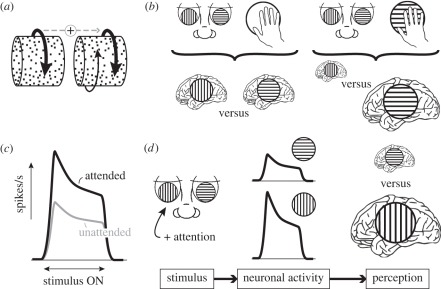Figure 3.
(a) An ambiguous rotating structure-from-motion cylinder (right) can become stabilized by a simultaneously presented coaxial unambiguous cylinder. As a consequence, both cylinders are mostly perceived to rotate in the same direction. (b) Unambiguous tactile orientation information biases perception during binocular rivalry between oriented gratings towards the grating that is congruent with the tactile information. Stimulation is depicted in the top row using eye and hand icons. Perception is indicated with brain icons, where larger icons indicate a greater dominance of the corresponding percept. (c) Schematic effect of attention on the response magnitude of a single neuron. A neuron will produce significantly more action potentials in response to an attended stimulus than to an unattended one. (d) If one of two gratings engaged in binocular rivalry is attended, the neurons representing that grating respond more vigorously than the neurons representing the opposite grating. This difference in activity may cause the attended grating to be dominant for larger proportions of time than the unattended grating.

